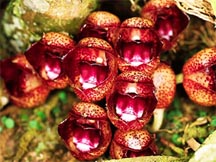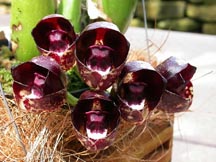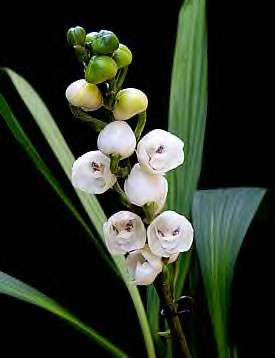

The type species of the genus Peristeria is the ‘Dove Orchid’ or ‘Holy Ghost Orchid’ or Peristeria elata. This orchid is native to South America from Panama, through Colombia, to Ecuador. In its native habitat, P. elata can be found growing near the edge of hardwood forest. As these hardwoods loose their leaves in the fall, the peristerias are exposed to full sun throughout the dry, cool winter. Some people say that having good, bright light during the rest period is especially beneficial to flowering.
The plant has long pleated leaves borne at the top of large round pseudobulbs when mature. The pseudobulbs can nearly reach the size of a softball in well grown specimens. The plant has received the name "Dove Orchid" because of its white cup-shaped flowers that have what resembles a dove in the center. Hence the name "Holy Ghost" or "Dove" orchid. This is the national flower of Panama and a protected, Appendix I species. Never purchase specimens taken from the "wild."
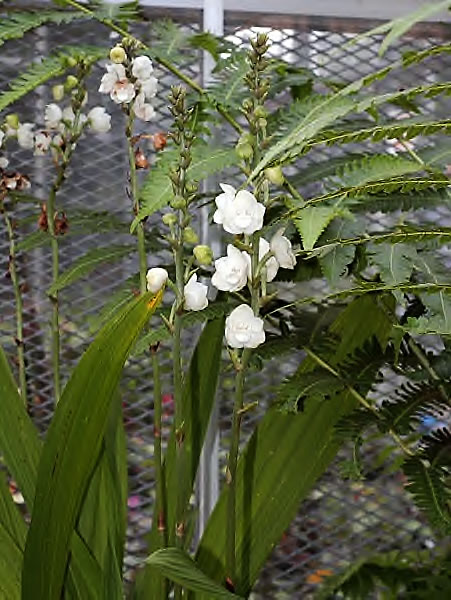

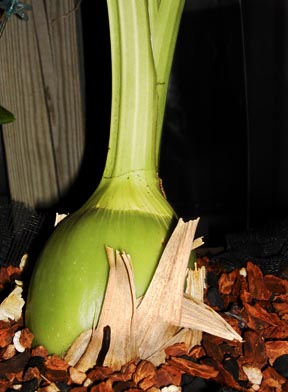
Light:
This plant can be grown in a wide range of light conditions, from Cattleya light
and higher. 2,000 to 4,000 foot candles. Reportedly, the species also does
well under a 430 watt high pressure sodium fixture when grown 3 feet from the
bulb to the top of the leaves.
Temperature:
Peristeria elata prefer intermediate to warm temps with winter days
in the mid 70s and nights not colder than 60 degrees Fahrenheit.
Humidity:
50% or higher is ideal. The use of humidity trays or room humidifiers is
beneficial.
Water:
It is important to water this plant with clean water such as rain, distilled,
or reverse osmosis. Except during the winter, the plant never wants dryness
at the roots. The roots are hairy like a paphiopedilum, and require moisture
at all times. The pseudobulbs should always be plump, round, and full.
If they start shriveling, this is most likely a sign they haven't been
watered enough. In the winter, try to mimic the dry season by leaving the
plant somewhat drier in between waterings. At this time of year, it is
OK to allow the pseudobulbs to shrivel slightly. Do this from the end
of November through mid to late January. Overwatering can cause several
problems such as root rot and infectious bacteria/fungus in the potting
medium.
Fertilizer:
Use GrowMore 20-10-20 Urea-free for municipal or well water. Use at the rate
of ½ teaspoon per gallon. If using GrowMore with rain, distilled, or reverse
osmosis water, add back in 5 - 10% municipal or well water to supply the
necessary calcium and magnesium. Fertilize every other watering in the
summer and every third watering in the winter. Other fertilizers offered
are as follows: GrowMore 6-30-30 (Cymbidium and bloom boosting formula)
and GrowMore 20-6-16 (Tropical plant food with calcium and magnesium additives).
Flowering:
Flowering season is usually late spring. The spikes can reach up to nearly
3 feet in height with up to 20 wonderful thick white flowers with a dove
inside that has purple spots on its tail (on the flower lip). The flowers
are long lasting (2-3 months) and are extremely fragrant.
Repotting:
It is best to repot if necessary just after flowering. Use a coconut husk
mix for best results. Orchids Limited bark mix, New Zealand sphagnum moss,
coco husk, coco peat, sponge rock, charcoal, tree fern fiber, osmunda fiber,
and cork slabs for epiphytic plants all make good planting material.

* Peristeria laeta
* Peristeria lentiginosa
* Peristeria leucoxantha
* Peristeria lindenii
* Peristeria longiscapa
* Peristeria maculata
* Peristeria pendula
* Peristeria rossiana
* Peristeria selligera
* Peristeria serroniana
* Peristeria stapelioides
* Peristeria violacea
